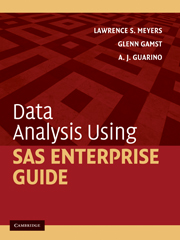Book contents
- Frontmatter
- Contents
- Preface
- Acknowledgments
- I Introducing SAS Enterprise Guide
- II Performing Analyses and Viewing Output
- III Manipulating Data
- IV Describing Data
- V Score Distribution Assumptions
- VI Correlation and Prediction
- VII Comparing Means: The t Test
- VIII Comparing Means: ANOVA
- IX Nonparametric Procedures
- X Advanced ANOVA Techniques
- XI Analysis of Structure
- 32 Factor Analysis
- 33 Canonical Correlation Analysis
- References
- Author Index
- Subject Index
32 - Factor Analysis
Published online by Cambridge University Press: 05 June 2012
- Frontmatter
- Contents
- Preface
- Acknowledgments
- I Introducing SAS Enterprise Guide
- II Performing Analyses and Viewing Output
- III Manipulating Data
- IV Describing Data
- V Score Distribution Assumptions
- VI Correlation and Prediction
- VII Comparing Means: The t Test
- VIII Comparing Means: ANOVA
- IX Nonparametric Procedures
- X Advanced ANOVA Techniques
- XI Analysis of Structure
- 32 Factor Analysis
- 33 Canonical Correlation Analysis
- References
- Author Index
- Subject Index
Summary
Overview
Factor analysis refers to a set of procedures whose goal is to organize a relatively large set of variables into a few sets of interrelated variables. One common application of the technique is to identify the subscale structure of a paper-and-pencil inventory. Specifically, we can use factor analysis to organize a set of items on an inventory into relatively homogeneous subsets. Items that are relatively strongly related to a factor may be combined together in the scoring system to yield a subscale score.
Some history
We generally ascribe the origin of factor analysis to Charles Spearman (1904a), who, according to Harman (1962), developed this statistical tool in the process of constructing his theoretical model of intelligence. Spearman's intent was to determine the conceptual dimensions underlying a series of mostly perceptual and memory testing modules (e.g., sensory discrimination of tones, just noticeable difference measurements for weights, memory span) that he had administered to over 100 English school children that were presumed to measure aspects of intelligence. However, Harman also tells us that one of the bases for Spearman's mathematical treatment of the data was published in an earlier paper by Karl Pearson (1901), who should therefore share a small portion of the credit for the development of the procedure.
Information
- Type
- Chapter
- Information
- Data Analysis Using SAS Enterprise Guide , pp. 327 - 344Publisher: Cambridge University PressPrint publication year: 2009
